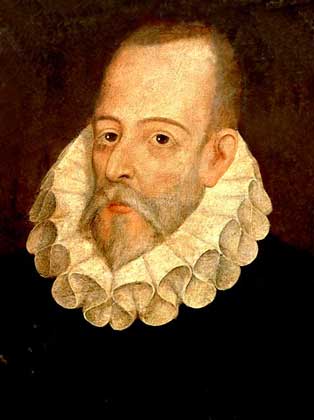The directory «Plots»
Cervantes Saavedra, Miguel de
(1547–1616)
«Don Quixote de la Mancha»

Spanish novelist, dramatist, and poet, author of Don Quixote de la Mancha, b. Alcalá de Henares.
Little is known of Cervantes’s youth. He went to Italy (1569), where, in the service of a cardinal, he studied Italian literature and philosophy, which were later to influence his work. In 1570 he enlisted in the army and fought in the naval battle of Lepanto (1571), receiving a wound that permanently crippled his left arm. While returning to Spain in 1575 he was captured by Barbary pirates and was sold as a slave; he eventually became the property of the viceroy of Algiers. After many attempted escapes, he was ransomed in 1580, at a cost that brought financial ruin to himself and to his family. As a government purchasing agent in Seville (1588–97), Cervantes proved less than successful; his unbusinesslike methods resulted in deficits, and he was imprisoned several times.
His first published work was an effusive pastoral romance in prose and verse, La Galatea (1585). Between 1582 and 1587 he wrote more than 20 plays, only two of which survive. He was 58 when Part I of his masterpiece, Don Quixote (1605; Part II, 1615), was published. As a superb burlesque of the popular romances of chivalry, Don Quixote was an enormous and immediate success. A spurious Part II was published in 1614, probably spurring Cervantes to complete the work.
Don Quixote is considered a profound delineation of two conflicting attitudes toward the world: idealism and realism. The work has been appreciated as a satire on unrealistic extremism, an exposition of the tragedy of idealism in a corrupt world, and a plea for widespread reform. Whatever its intended emphasis, the work presented to the world an unforgettable description of the transforming power of illusion, and it has had an indelible effect on the development of the European novel.
Don Quixote is a country gentleman who has read too many chivalric romances. He and the peasant Sancho Panza, who serves as his squire, set forth on a series of extravagant adventures. The whole fabric of 16th-century Spanish society is detailed with piercing yet sympathetic insight. The addled idealism of Don Quixote and the earthy acquisitiveness of Sancho serve as catalysts for numerous humorous and pathetic exploits and incidents. Its panorama of characters, the excellence of its tales, and its vivid portrayal of human nature contribute to the enduring influence of Don Quixote.
In later years Cervantes wrote other works of fiction, including Novelas ejemplares (1613), 12 original tales of piracy, Gypsies, and human passions, drawn from his own experience and molded by his mature craftsmanship. Some of these stories in themselves prove him to be one of the world’s great literary masters.
Argentina, 1975, Don Quixote
Bolivia, 1961, Miguel de Cervantes
Bolivia, 1961, Miguel de Cervantes
Bolivia, 2005, Don Quixote
Chad, 1982, Monument of Cervantes in Madrid
Chili, 1947, Miguel de Cervantes
Chili, 2005, Don Quixote
Chili, 2005, Windmile
Chili, 2005, Windmiles
Chili, 2005, Don Quixote
Chili, 2006, Don Quixote
Colombia, 1978, Don Quixote (L. A. Acuna)
Colombia, 2005, Don Quixote
Costa Rica, 1947, Miguel de Cervantes
Costa Rica, 1947, Miguel de Cervantes
Croatia, 1997, Don Quixote and Windmill
Cuba, 1967, «Don Quixote»
Cuba, 1972, In La Mancha
Cuba, 1972, Battle with the Wine Skins
Cuba, 1972, Don Quixote of La Mancha
Cuba, 1972, Scene from «Don Quixote»
Cuba, 2005, Miguel de Cervantes and «Don Quixote»
Dominican Republic, 1958, Cervantes, Open Book, Marker and Globe
Dominican Republic, 1958, Cervantes, Open Book, Marker and Globe
Dominican Republic, 1958, Cervantes, Open Book, Marker and Globe
Ecuador, 1949, Miguel de Cervantes and «Don Quixote»
Ecuador, 1949, Miguel de Cervantes and «Don Quixote»
Ecuador, 1949, Miguel de Cervantes and «Don Quixote»
Ecuador, 1949, Miguel de Cervantes and Windmill
Ecuador, 1949, Miguel de Cervantes and «Don Quixote»
Ecuador, 1949, Juan Montalvo and Cervantes
Ecuador, 1949, Don Quixote
Ecuador, 1949, Juan Montalvo and Cervantes
Ecuador, 1949, Don Quixote
Ecuador, 1949, Juan Montalvo and Cervantes
Ecuador, 2005, Don Quixote and Windmills
Ecuador, 2005, Don Quixote and tree of books
Equatorial Guinea, 1975, Battle
Equatorial Guinea, 1975, Don Quixote meet a knight
Equatorial Guinea, 1975, Don Quixote
Equatorial Guinea, 1975, Don Quixote of La Mancha
Equatorial Guinea, 1975, Don Quixote and Windmill
Equatorial Guinea, 1975, Battle
Equatorial Guinea, 1975, Don Quixote
Equatorial Guinea, 1975, Scene from «Don Quixote»
Equatorial Guinea, 1975, Don Quixote and Windmill
Equatorial Guinea, 1997, Miguel de Cervantes and «Don Quixote»
Equatorial Guinea, 2005, Don Quixote
Chili, 2006.05.31,  Santiago. Don Quixote
Santiago. Don Quixote
Colombia, 1978.08.09,  Bogota. Don Quixote and Sancho
Bogota. Don Quixote and Sancho
Croatia, 1997.02.07,  Zagreb. Miguel de Cervantes
Zagreb. Miguel de Cervantes
Cuba, 1972.12.25,  Havana. Windmills
Havana. Windmills
Cuba, 2005.01.24,  Havana. Don Quixote and Sancho
Havana. Don Quixote and Sancho